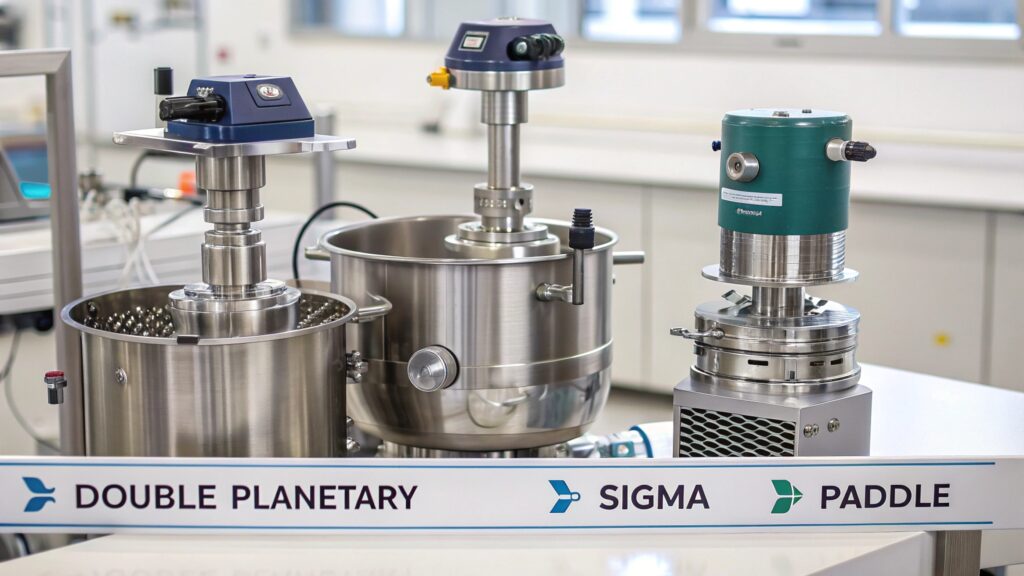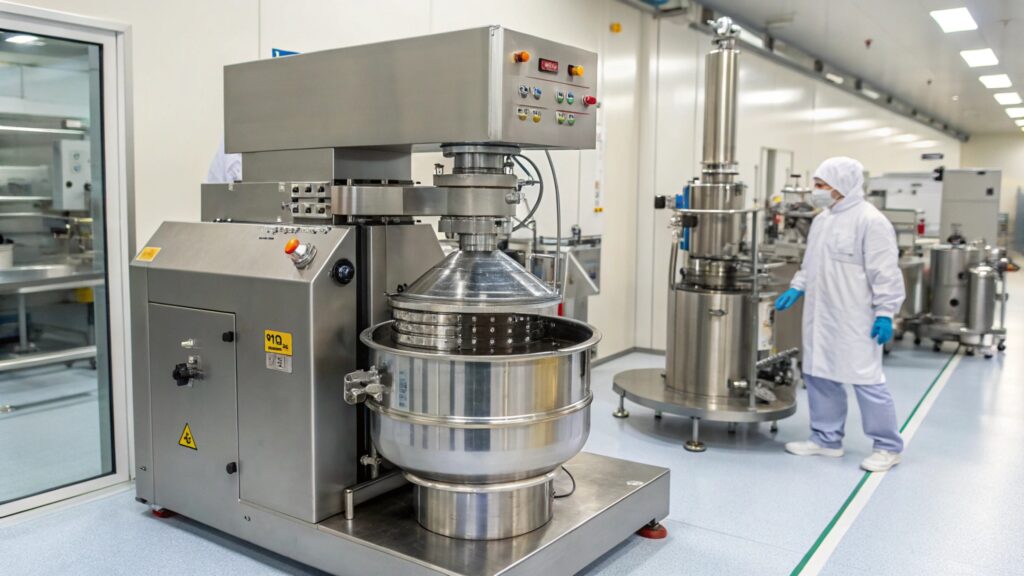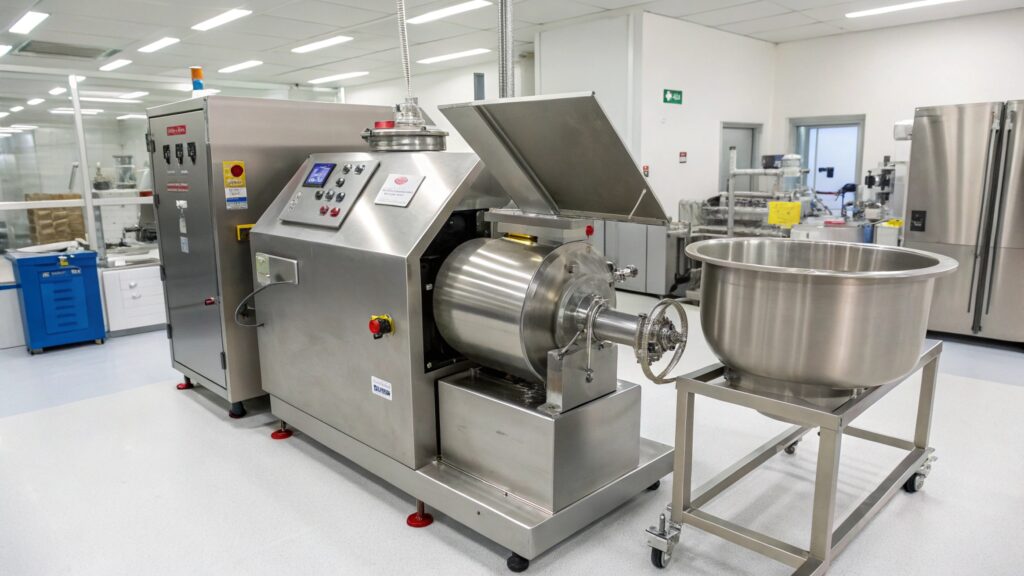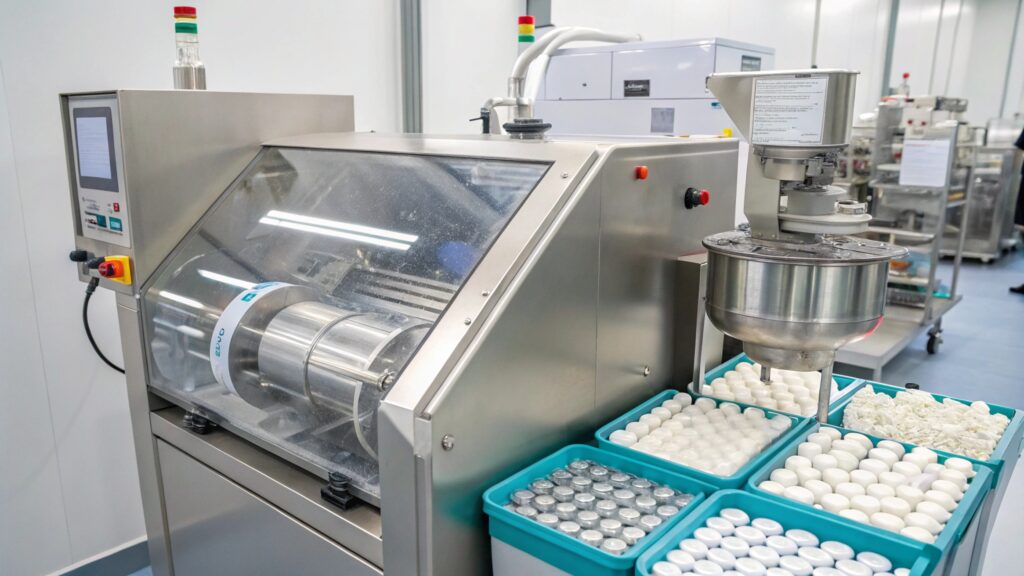Choosing the wrong mixer for biopharma production can cost millions in failed batches and regulatory compliance issues.
Double planetary mixers excel in high-viscosity biopharmaceutical applications, while sigma mixers handle paste-like materials and paddle mixers work best for low-viscosity solutions.
After ten years of manufacturing mixing equipment at MIXERSTAR, I’ve seen countless biopharma companies struggle with mixer selection. The wrong choice doesn’t just affect product quality – it can derail entire production lines and regulatory approvals.
Why Are Double Planetary Mixers the Gold Standard for High-Viscosity Biopharma Applications?
Double planetary mixers dominate biopharma facilities because they handle complex mixing challenges that other equipment cannot manage.
Double planetary mixers provide superior mixing efficiency for high-viscosity pharmaceutical formulations through dual rotation mechanisms that ensure complete material contact and uniform distribution.
I remember working with a German pharmaceutical company that struggled with inconsistent vaccine adjuvant production. Their existing paddle mixer couldn’t handle the high-viscosity emulsions properly. After switching to our large industrial mixers, their batch consistency improved by 40%.
Double planetary mixers work through a unique dual-motion system. The mixing blades rotate around their own axis while simultaneously orbiting the mixing bowl. This creates multiple shear zones that break down agglomerates and ensure complete mixing. The vacuum capability removes air bubbles that could compromise product stability.
| Feature | Benefit for Biopharma |
|---|---|
| Dual rotation system | Eliminates dead zones completely |
| Vacuum operation | Prevents oxidation of sensitive compounds |
| Temperature control | Maintains protein stability |
| High shear capability | Reduces particle size distribution |
The vacuum feature proves critical for oxygen-sensitive biologics. Many protein-based drugs degrade when exposed to air during mixing. Our medium-scale planetary mixers can achieve vacuum levels down to 0.1 mbar, protecting valuable biologic compounds from degradation.
Cleaning validation becomes simpler with double planetary mixers[^1]. The smooth bowl design and removable blades allow thorough cleaning between batches. This matters enormously in biopharma where cross-contamination can render entire production runs unusable.
When Do Sigma Mixers Excel in Pharmaceutical Manufacturing Processes?
Sigma mixers handle paste-like pharmaceutical formulations that would overwhelm other mixing technologies through their robust kneading action.
Sigma mixers excel with high-solid content pharmaceutical pastes, ointments, and dense formulations requiring intensive kneading rather than conventional mixing.
Last year, I worked with a topical medication manufacturer who needed to mix zinc oxide ointments with 60% solid content. Their existing equipment couldn’t handle the thick consistency. Sigma mixers[^2] solved this challenge through their unique Z-blade design[^3].
Sigma mixers[^2] use two Z-shaped blades that rotate at different speeds. This creates intensive kneading action that breaks down lumps and distributes ingredients evenly. The blades work like giant hands, folding and pressing the material repeatedly.
The heating and cooling jacket system allows precise temperature control during mixing. This proves essential for temperature-sensitive APIs that might degrade under excessive heat. Many pharmaceutical pastes require specific temperature profiles to achieve proper consistency.
| Application | Why Sigma Mixers Work |
|---|---|
| Antibiotic ointments | Handles high-solid content |
| Transdermal patches | Uniform drug distribution |
| Suppository bases | Temperature-controlled mixing |
| Dental impression materials | Consistent paste texture |
Discharge mechanisms in sigma mixers accommodate thick materials that won’t flow freely. The tilting bowl design allows complete evacuation of high-viscosity products. This minimizes waste and ensures batch-to-batch consistency.
One challenge I’ve observed with sigma mixers involves cleaning complexity. The Z-blade design[^3] creates more surface area that requires validation. However, the intensive mixing action often produces superior homogeneity compared to other technologies for appropriate applications.
How Do Paddle Mixers Serve Low-Viscosity Pharmaceutical Applications?
Paddle mixers provide gentle, efficient mixing for low-viscosity pharmaceutical solutions where product integrity must be preserved during processing.
Paddle mixers excel with low-viscosity pharmaceutical solutions, offering gentle mixing action that preserves delicate compounds while ensuring uniform distribution.
A recent project involved mixing IV solutions with multiple electrolytes. The customer needed gentle mixing[^4] to prevent precipitation while ensuring complete dissolution. Paddle mixers[^5] provided the perfect solution through their low-shear mixing action.
Paddle mixers[^5] use large, slow-moving blades that create gentle circulation patterns. This approach works well for solutions containing heat-sensitive vitamins or proteins that might denature under high shear conditions. The mixing action resembles stirring rather than intensive blending.
The variable speed control allows operators to adjust mixing intensity based on product requirements. Fragile compounds might require very slow mixing speeds, while more robust formulations can handle faster operation. This flexibility makes paddle mixers versatile for different pharmaceutical applications.
| Product Type | Paddle Mixer Advantage |
|---|---|
| IV solutions | Gentle mixing prevents precipitation |
| Liquid vaccines | Preserves protein structure |
| Oral suspensions | Maintains particle size |
| Buffer solutions | Controlled pH mixing |
Tank design considerations become important with paddle mixers. Baffles help create proper circulation patterns and prevent vortex formation. The tank geometry affects mixing efficiency significantly. Proper design ensures all material contacts the paddle blades regularly.
Heat transfer capabilities through jacketed tanks allow temperature control during mixing. Many pharmaceutical solutions require specific temperatures for optimal solubility. The large surface area of paddle mixer tanks provides efficient heat transfer.
Cleaning systems integrate easily with paddle mixers. CIP (Clean-in-Place) spray balls can reach all tank surfaces effectively. The simple blade design minimizes cleaning validation requirements compared to more complex mixing systems.
Our custom mixing solutions often involve paddle mixers for clients who need specialized tank configurations or unique blade designs for specific pharmaceutical applications.
Conclusion
Choose double planetary mixers for high-viscosity applications, sigma mixers for paste-like formulations, and paddle mixers for gentle solution processing.
External link
[^1]: Learn about the unique features of double planetary mixers that ensure optimal mixing and product stability in biopharma.
[^2]: Explore how Sigma mixers enhance efficiency and consistency in pharmaceutical processes, ensuring high-quality products.
[^3]: Learn about the innovative Z-blade design and its impact on mixing performance, crucial for achieving optimal product quality.
[^4]: Discover why gentle mixing is crucial for preserving sensitive compounds and preventing precipitation in pharmaceutical formulations.
[^5]: Explore this link to understand how paddle mixers enhance mixing efficiency and maintain product integrity in pharmaceuticals.








